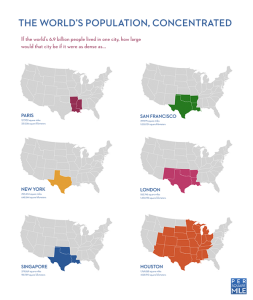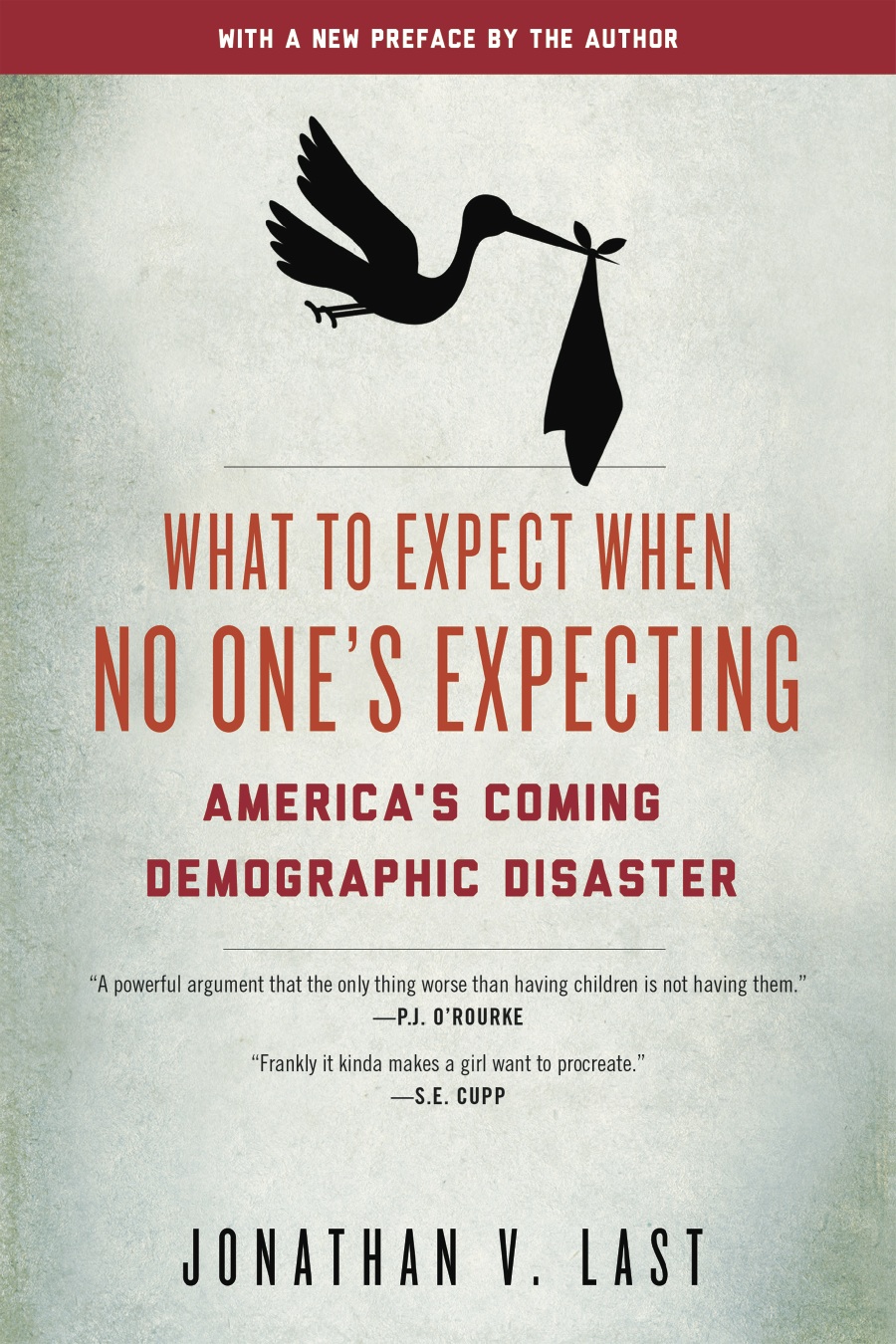July 13th, 2012
When I write about demographics and the problems with the world’s collapsing fertility rate the first bit of pushback I get is always the same: But the world is overcrowded already! We don’t need more people!
The second part of this argument is complicated but the first is not. The world only looks overcrowded if you live in a major metropolitan area. America, for instance, may look overcrowded if you live in New York or Los Angeles, but the view from Montana is quite different. Yesterday Galley Friends B.W. and K.S. sent me this wonderful graphic on how much space it would require to fit the entire world’s population in one place, using the densities of some pretty livable, modern cities. (Click to enlarge.)
There’s no real point to this–it’s a rhetorical exercise. But it highlights pretty nicely how uncrowded the world is. There are other arguments against population growth, but overcrowding isn’t one of them.
-
“Demography” was a $2,000 Jeopardy question last night.
-
Looking at the map I don’t see any coverage for Arizona, let alone Saudi Arabia….
…and speaking as an Arizonan not sure what you mean by “taking… Arizona” out of the picture. Yep Arizona is hot for 4 months out of the year and is mostly desert but over the past 50 years it is also one of the fastest growing states. In fact with air conditioning and proper water supply there is no reason why it cannot keep growing for another 40. So given modern technology, people are able to (in fact desire) to live in places that were once largely uninhabitable.
What Last’s maps do is to provide a degree of precision to the terms of the debate – from the mere “we’re running out of physical space” to perhaps “we’re using the wrong type of space (such as arable land) for habitation” or more than likely smoking out true ulterior motives such as environmental watermelonism (green/red).
I do find it rather comical that people from a few densely populated parts of the world- Mid-Atlantic states, California, Europe – are usually the ones carping about running out of room but that you see few westerners
-
I think you missed what I was asking: how big (comparatively) is livable and arable land, when you compare it to population size? How much land doesn’t suck balls to live on? THEN you make the comparison: the comparison isn’t the world (why not use the water too, if you’re saying I can live with a cactus up my ass or on the Antarctic?). Mr. Last should show his work.
I’m just saying, be fair: show how people are distributed on a planet worth living on. A shitload of our planet ain’t.
Does ANYone get the point I’m making?
-
Oh yeah. We get it. The problem is, it’s really hard to find out percentages of arable land, globally. You’ve got to type all of these words into the Google and then press enter.
Then you’d see stuff like this:
http://en.wikipedia.org/wiki/File:Arable_land_percent_world.pngI’m only a scientologist, not an actual scientist, but it looks to me like there’s a pretty good sized chunk of rock that’s livable even without man-made interventions like Phoenix. For instance, 40% of the land in India is arable. India is 1.3 million square miles. Texas (which is the projection for NYC-level density) is 270,000 square miles.
Oh, but we should all show our work, right? Hmmm, 40% of 1.3 million is 2.76 million . . . wait, that’s not right. Well I’m not good at math, but I’m pretty sure it’s more than 270k. I’ll leave the arithmatic to you. But it looks like India alone would more than have us covered, leaving THE ENTIRE REST OF THE PLANET as campground, farm-land, eco-rape zone.
You know, you could have dug this up in a quarter of the time it took you to whine about fairness. So did you really want to know the answer to your own question, or did you just want to show us all how fair and concerned you are?
Don’t worry, we’re all really impressed. We know you’re not one of those Republithug, Christianist breeders with their simplistic view of the world.
-
To be honest, I don’t know how to respond to a person who says “I’m only a scientologist” other than backing away with nervous eyes, smiling until I can run.
I don’t see the problem: there have to be various well placed estimates around: why do I have to have exact numbers for this? It’s a general comparison. Last was making a general point as well.
I don’t know why you brought up the Christers, that comment just sort of came out of nowhere: I don’t need validation, I just liked Last’s point while seeking modification.
-
I understood the point you were making it’s just that 1 of the 2 examples you were using of unlivable land, Arizona, was so poor given that the state’s massive growth of its population that it overwhelms a great deal of your argument .
I mean you knew that millions of people like living in the arid, largely desert Great Basin states, right? And that a big chunk of the Arizona economy used to be agriculture, right? So why do you want to take Arizona out of the equation? You don’t like cactus? Fine – but alot of people do and you’re the one trying to generalize to the larger population.
Yeah I know there are places where people will probably never want to live in huge numbers – e.g. Arctic coast of Siberia, Acoma Desert… – but advances in technology (and I don’t just mean air conditioning – for starters think disease control in the tropics) have opened up vast areas of the world to farming and large populations.
All it takes is technology, some capital, and a little human ingenuity – ask Bugsy Siegel and the guys who created Hoover Dam how that little desert town in southern Nevada turned out.
I’ll top you and tell you the study that I want Last to point or someone else to perform and that is do a historical analysis of what people thought over the past 500 years or so constituted the maximum living/arable area of the planet and then show how that has changed – don’t go back 500 years maybe just go back 200 years and show how Americans thought that the area between the Mississippi and the Sierra Nevadas/Cascades was the Great American Desert and therefore not wanted.
-
I realize it’s not exact science, but Arizona is not the Saudi kush, so to speak: it’s a not-very-wide spot of arid blah surrounded by water, with underground water and everything: not exactly real desert.
This is exactly what I didn’t want to do. This is precisely the reason I didn’t care about the small stuff: ok ok ok, there are differing levels about what is livable, I get it. Why not shock our professors and make several comparisons? Christ, I’m not asking for a Christ Regression I’m asking for a comparison.
All you’re telling me is we should maybe make a few instead of one. Well, good. But you seem to be saying “Thus! Forsaken Knowledge of Man, that We might Look into the Sun for Divine Spark! The Gods Will Punish Us!!” just because there might be some wiggle room in the word “arid”. Ok ok, it might be complicated. I however, refuse to believe it’s the Quadratic Equation of general sums.
-
I get the basic point you’re making, Mr. Versluys, and it’s a valid one in the big-picture sense: Whenever we discuss whether the world is “overpopulated,” we do need to remember that not all land is created equal, at least when it comes to supporting the existence of homo sapiens.
However, I think in all this back-and-forth you and the other commenters are missing the forest for the trees, so to speak. Let’s stipulate (very conservatively!) that the total amount of livable/arable/doesn’t-suck-balls-to-live-on land on the entire Earth only matches the total area of the continental U.S. As the graph above shows, even if the entire current population of the earth were living at the density of a spread-out-as-hell metropolitan area like Houston, we’d still have a whole lot of livable land left. When you combine this reality with the declining worldwide birth rates that JVL and others have written about so well, it paints a pretty embarrassing picture for the population-control worry-warts.
btw, I grew up in TX and sympathize with your plight (living in Houston, I mean). But never underestimate the benefit of being within driving distance of truly good Texas barbecue. 🙂
-
That’s fair criticism to make of me, ok (on missing forests for trees): I probably should have known any complications of the original would just open up the matterhorn to…well, every complicating factor, outlier, and definition squabble imaginable. Come to think of it, it’s my fault: I should know better than to speak in class.
The only thought I have on your second paragraph is that I say (again and again) that I buy Last’s thesis on world population: ain’t hardly nobody on my grass right now and I can’t hear any of my neighbors. I wasn’t attacking his thesis, I was trying to flush it out in the open.
Fuck BBQ (Forgive me, Gods, forgive me): Tex-Mex is the thing I can’t live without. And as far as I can tell, it exists here only: travelled everywhere, and I’ve had shit-to-ok Tex Mex everywhere. Mexicans can’t make it for shit either: it’s Texas messicans or nothing. Not Mexican, Tex-Mex. It’s ambrosia.
-
Yeah, yeah. My kitchen is feeling a little overpopulated right about now.
-
Actually, it kind of makes sense to build houses in shitty Arizona and then grow food everywhere else. But that raises another question. Exactly how much Earth is required to sustain (i.e., food, water, other resources) the total population, whether it’s spread out or stacked on top of each other like gay Paree? A lot of city folk actually think fresh fruit comes from the corner market and fresh water comes from the tap.
-
You hit the nail on the head. While we theoretically could stack everyone in Texas we how much of the rest of the world would it take to provide food, water, and other natural resources? Then if we have water plants pumping water from all over the world we need people to operate them, so then they need to live close by their work, so then the population gets spread out…etc. etc. And while we might have plenty of room for all these people it doesn’t mean we have enough resources, so this whole graph is rather pointless other than a theoretical debate.








James Versluys July 13, 2012 at 10:44 pm
I buy it, but I would like a side-by-side comparison with two other maps to make your point perfectly against its counter-evidence: 1) the size of liveable and 2) arable land people can actually live on and grow stuff in: meaning, taking shitty Saudi desert and Arizona out of the picture, how people stack up against *decent* land.
I’m not popping your thesis, I just think it’s a useful comparison: it would take a bit of triumphalism out of your thesis (I’m sure if we stack people in bundles we could get it down to Jersey Shore. And half the Senate deserves nothing less) but would also clearly show if you have a good point. My guess: it would deflate you a bit, but still make the point on a lesser scale.
It’s just that, I live in Houston, so fuck that.